FATHER DE NANTES IN CANADA
A Master, a Father, a Victim
IT was twenty-five after midnight on this side of the ocean, 6:25 A.M. in France, when Father Georges de Nantes, our beloved Father peacefully gave up his beautiful soul to God on February 15, 2010. In the Letters to the Phalange nos 85 and 86 Brother Bruno of Jesus, who succeeded him at the head of our Community, related the circumstances of this death of a just man, surrounded by his Community, and the following issues of He is Risen! would recall his « fine reign » and his fight to defend the Faith.
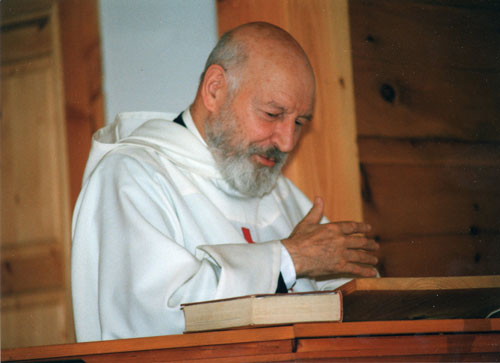
after returning from exile in 1997.
We would simply like to recall here the memory he left us of a paternal heart, always looking after his own in faith and charity, and manifesting an invincible hope. Let us recall first how his zeal for the salvation of souls brought him all the way to Canada.
« HELP, DEAR CONFRERE! »
As a young theologian, thirty-eight years old, Father de Nantes immediately opposed the innovations of Vatican II. He foresaw that they would cause the ruin and the decadence of Christian nations and the Church. The circulation of his Letters to My Friends had increased considerably during the Council. His pertinent analyses, marked with supernatural wisdom in the defence of the Faith, earned him the esteem of a priest from Montreal, Father Henri Saey.
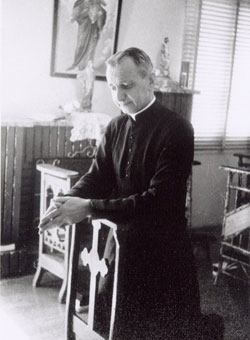 On October 16, 1966, he dared to write to him: « Help, dear confrere… your prayers please, and those of your most fervent friends!!! » There followed a detailed account of the drama of conscience of this holy priest who was caught between the obedience due to his archbishop, who was organising the pastoral revolution in his diocese, and the advice of integrists who urged him to resign and engage in resistance.
On October 16, 1966, he dared to write to him: « Help, dear confrere… your prayers please, and those of your most fervent friends!!! » There followed a detailed account of the drama of conscience of this holy priest who was caught between the obedience due to his archbishop, who was organising the pastoral revolution in his diocese, and the advice of integrists who urged him to resign and engage in resistance.
Our Father’s wise answer put his mind at rest and reinforced him in the repulsion he felt for schism. It was the beginning of a long friendship that Father Saey would have liked his confreres to share. In November 1973, he did not hesitate to publish this testimony in a Montreal traditionalist journal:
« In the present self-demolition of our Church, which came about within as a consequence of the tepidity of her sons, and was carried out externally by her leaders, indeed by her very Head, Father de Nantes salvaged, saved, thousands of souls (…). From the first contact I had with this man of God, and in the thousands that followed, I was consoled, delighted to find nothing, absolutely nothing on his lips and from his pen, other than the teaching of the Gospels, of SS. Peter, Paul, James, Jude, and John, of the Holy Fathers and Doctors (…) a teaching that is as pure as crystal, solid as a diamond, sweet as honey. »
Encouraged by such support, our Father agreed in 1974 to go to Canada to explain his “high ground”, « neither schism, nor heresy », to the priests and faithful who were disconcerted by the liturgical reform, which worsened, it seemed to them, the baneful consequences of the “Quiet Revolution”. His conferences attracted an interested public that was rapidly won over to this priest who was not at all a “hypercritical Frenchman”. The rigour of his theological demonstration and his supernatural wisdom that safeguarded truth and charity, impressed the listeners and created a fine unanimity that could have been the starting point of a movement of Counter-Reformation in a French Canada in which the Catholic Faith still remained solidly established.
Unfortunately, a few months later Archbishop Lefebvre, then Father Barbara, a French sedevacantist, came in turn to Quebec to revive the quarrel concerning the validity of the new Mass. The traditionalist priest from Sainte-Yvette’s parish in Montreal, who had first been won over by our Father’s wisdom, changed his mind and openly opposed his archbishop until he was evicted by main force from his rectory. This was precisely what our Father wanted to avoid in order not to discredit the traditionalist cause in the eyes of a clergy that was always respectful of the hierarchy.
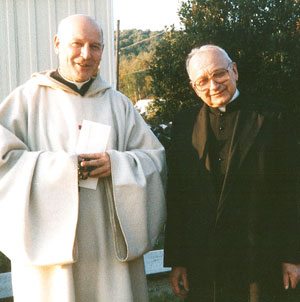
Following these events, Father Saey wrote a moving letter to our Father to confide to him a torment that was and remains that of many of his disciples:
« Obviously, Father, it upsets us that because of such divergent opinions, now even here in Quebec, and because of the recent events in Sainte-Yvette’s parish, priests and laymen are distancing themselves from us, and now consider us their enemies, or at least cowards who are abandoning them in their fight!!... But in truth, what is this tiny sorrow, Father, compared to the profound distress that has been tormenting me for months: Why, why do they not have recourse in the Church, from the top to the bottom of the ladder, to the wisdom of Father de Nantes? Why, why do they ignore it to such an extent in the integrist, traditionalist milieus? That is a true torment! I take refuge in the Faith. »
From this first stay of our Father in Canada we have his Way of the Cross, which our Communities have recited so many times since then without us ever growing tired of it; it alone suffices to bear witness to the piety and profundity of the soul of its author. Our Father wrote and preached it for the first time in Saint Raphael’s chapel in Shawinigan, where an elderly and holy Oblate of Mary Immaculate missionary, Father Henry, said the Tridentine Mass with the benevolent permission of the Bishop of Trois-Rivières. Who would have supposed then that thirty years later, our Maison Sainte-Thérèse and Maison Saint-Georges would stand in the same place?
I am getting ahead of myself. After the quarrel over the Mass, it was the issue of Quebec independence that perturbed those whom integrism and sedevacantism had not already driven away from the CCR. Our Father sent them Brother Bruno in 1977 and 1978; he himself returned in 1979 and 1981, but only to observe that the fine promises of a flourishing Canadian CCR had fizzled out. Others in his position would have turned towards other, more promising, horizons. Our Father’s heart, however, had already attached itself to his few isolated friends who were subjected to all sorts of propaganda, but who remained faithful, with great merit. Rather than abandoning them, he resolved to send them a few brothers to found here an outpost of Maison Saint-Joseph.
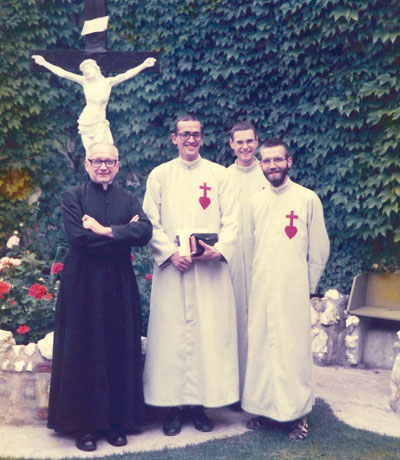
THE FOUNDING OF OUR HOUSES
As an old farm situated at Saint-Gérard-des-Laurentides, near Shawinigan, had been put at his disposal, our Father decided that the foundation would take place under the patronage of St. Thérèse of the Child Jesus and of the Holy Face. The brothers inaugurated their monastic life there on June 16, 1982 by chanting the first vespers of the Feast of the Sacred Heart.
Previously, as our Father had ordered them to do, they had presented themselves at the bishopric in Trois-Rivières in order to inform the bishop of the diocese of their intentions.
A few months earlier, Archbishop Lefebvre had also founded a priory in Shawinigan, loftily ignoring the local clergy. From the outset, this difference in attitude created a favourable opinion of our foundation and established honest relations despite the fundamental differences that were not concealed.
Bishop Laurent Noël ordered the parish to open the church to the brothers for their visit to the Blessed Sacrament. The new parish priest who arrived a few days later, although a partisan of religious liberty, applied the instructions with benevolence. Our Father never neglected to make a social visit to him on each of his trips to Canada.
This climate of charity that our Father found beginning in the summer of 1983 was indeed what he had desired. He wanted to prepare the renaissance of the Church, which would necessarily come, by the elaboration of a doctrine that refuted error and exposed the truth in the present context, as well as by our attitude within the Church. In a sermon for the welcoming of the first Canadian postulants he said, referring to Maison Sainte-Thérèse:
« Here is our peace, and this peace is indeed the sign that this doctrine of Catholic Counter-Reformation and Counter-Revolution is not a revolutionary attitude, is not a heretical stubbornness, but quite simply our love of Christ’s Truth. »
In 1984, the house of our sisters was founded at Saint-Georges-de-Champlain. There as well, relations with the clergy were extremely courteous. The retired parish priest rapidly became a fervent, albeit discreet, listener to our cassettes, while the titular parish priest honestly admitted that there was a problem with the Council and recognised the legitimacy of our opposition as long as Rome had not rendered a judgement.
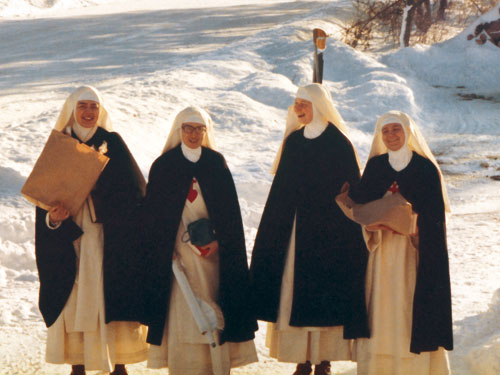
THE VERY SURE ROAD OF OUR CCR
Then began the peaceful history of our Canadian foundations. Our Father assigned them the goal of building « a dyke in the present storm. Those who want it will find shelter there ».
Each year, at the end of August, his visit raised spirits. In the early stages, the very modest beginnings made our friends fear that our Father would put an end to the experiment… He, however, always reassured them. He was attached to God’s will and the good of souls, however few, and not to brilliant successes! How many time had he repeated to his Community: « Here, it is either ambition or the vocation that succumbs! »
In 1984, he repeated to his friends that we were here « to show the very sure road of our CCR, almost equidistant between schism and heresy. Closer to integrism from the standpoint of the Faith, of understanding of the doctrine, but closer to the Church in its Conciliar state, why yes! Closer, in spirit, to the Catholic community as a whole – parish, diocese, Roman Church – even gone mad, even suspected of heresy, in order to remain in unity. »
Our friends respected these instructions all the more because the facts continually proved the exactitude of our Father’s analyses and the validity of his fight. His perceptiveness was evident here as in France, in particular on the occasion of John Paul II’s trip to Canada that autumn. Ten days before it took place, our Father commented on it to our friends gathered for a Congress! The future showed that he was not mistaken. It suffices today to re-read his conclusion:
« It will be, he told us, like what is sometimes seen when a ship is leaking like a sieve. At a certain moment, it seems, you see it stand up vertically, its prow raised towards the sky like beseeching hands. The prow rises; it is a veritable marvel. Then all at once the ship sinks and disappears forever beneath the waves. The resurrection of a new Church in Canada? There will not be one. It is the ancient Christianity that will be reborn or nothing. The Pope’s trip will only hasten the fall. »
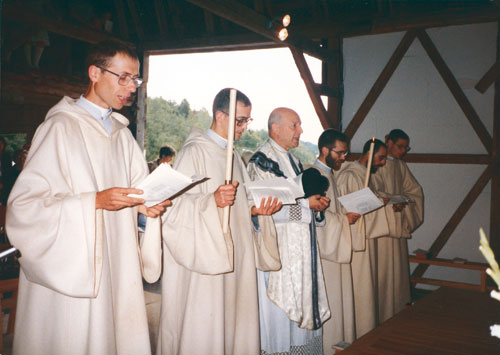
Since we are speaking about 1984, let us point out another characteristic of hischarism, his ability to grasp immediately the advantages of technical progress. That year, a good friend took the fortunate initiative of making a video cassette recording of his first conference of the Congress in order to show it after dinner to those who had arrived late. Our Father went to see it… and immediately decided that Maison Saint-Joseph ought to be equipped for video recording and distribution!
A PATERNAL HEART
With each succeeding year, the programme of the annual rendezvous of our Father with his small Canadian flock became established. He called it – perhaps ironically, because we did not leave him a minute free – « his vacation in Canada ». First weekend: clothing ceremony or reception of the veil; second weekend, that of Thanksgiving Day, a three-day retreat that prepared the one that he would preach to the Community in France; finally, the day or two days before his departure, the Congress, also in anticipation of the one that would be held in France.
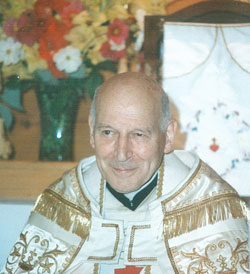 These three meetings, as well as the visits to the circles of Montreal and Sherbrooke, were for many the occasion of good spiritual direction, the fruits of which were not long in coming: several religious vocations and these beautiful families, often large families, in which the Faith and convictions were faithfully transmitted.
These three meetings, as well as the visits to the circles of Montreal and Sherbrooke, were for many the occasion of good spiritual direction, the fruits of which were not long in coming: several religious vocations and these beautiful families, often large families, in which the Faith and convictions were faithfully transmitted.
The foundation of the Phalange in 1985 and the prayers for the appeal to the Judgement of God in 1986-1987 strengthened still more the bonds of our spiritual family.
This was even more so due to the fact that at that same period we were proving that his doctrine, although elaborated in a completely different context, applied to the French Canadian situation with a result that went far beyond, as it were, the expectations. Our Father in fact furnished two keys to understanding our history which made it coherent, unlike the other historical theses, even the nationalistic ones.
His criticism of democracy relativises the English - French opposition in which French Canadian nationalism has been bogged down in for a century. If it explains the process by which the English were able to dominate, it does not for all that ignore the conditions which, in certain periods, allowed, and thus will once again allow French Canadians not only to resist assimilation, but to be the driving force behind a true Canadian nationalism.
The very rapid collapse of French Canadian Christianity also finds its explanation in our Father’s analysis of the doctrinal causes of the Church’s apostasy. It casts light on the consequences of Cardinal Tachereau’s liberalism at the end of the 19th century, then of Jacques Maritain’s personalism, which was spread here thanks to specialised Catholic Action. The breath of the Quiet Revolution would suffice to cause the collapse of French Canadian Christianity undermined from within by these two evils.
Our Father enlightened our intelligence while strengthening ever more our hope. After the triumph of the Immaculate Heart of Mary, the Counter-Reformation of a Third Vatican Council of restoration will revive Canadian Christianity that will get back in touch with its original vocation, resuming its valorous conquest of the continent for the Heart of Jesus and Mary. The sacred history of Canada has only been interrupted. It will resume its irresistible course!
Thus illuminated, this study of the history of the Church and of French Canada, taking part in the combat of the Church as a whole, has something exhilarating about it that also explains, to a great extent, the commitment of the new generations.
« THE HAPPINESS OF MAUNDY THURSDAY »
The wind of revolt which, in 1989, nearly carried off the CCR for the first time, had the providential consequence here of forcing our departure from Saint-Gérard and the building of our houses at Shawinigan on a vast property favourable to our activities, in particular those intended for youth.
In order to carry through successfully this costly project, out of proportion with the resources of the small Canadian CCR flock, our Father generated a great outpouring of generosity among our friends in France, and he wanted a plaque listing the names of benefactors in our chapel to retain the grateful memory of them. At Pentecost 1990 he wrote to the Phalange:
« On reflection, I have never attached so much importance to the purchase of land or the building of a house. What importance, then, do these particular ones have in our eyes, in our heart, that the others did not have? I believe that for us it is a symbol… It is an overwhelming task to advocate the Counter-Reformation and Counter-Revolution in the Church and in the world. Often we grow weary of it, persecuted on all sides to the point of seeing ourselves lost beyond all hope! Thus, in this year 1990, it is a joy to build, you together with us, a good, big, beautiful log house, truly evangelical and perfectly Canadian in style, to be an ark in the tempest in the New World and a sanctuary ready for the celebrations of the Church’s recovered peace, before ten year have elapsed. »
Poor Father… we would have to wait longer, for the persecutions of that time were only the harbinger of the great turmoil that was looming.
It struck the flock on August 6, 1996, when he was taken away from us for the first time. Those who lived through those events will never forget the anguish that gripped us during our meeting the following Sunday!
Yet, on the morning of August 13, what a surprise it was to hear him on the telephone announcing to us his arrival (for his annual visit in Canada) as planned! What had happened? The superior of the monastery to which he was supposed to withdraw judged our Father undesirable, and since he could not reach the Bishop of Troyes, our Father had the permission to come to Canada while awaiting other instructions for the future.
As far as the schedule of activities went, it was a visit similar to the previous ones though the expectation of the unavoidable separation, and for an undetermined length of time, made it entirely different. He preached to us on the life of Father de Foucauld whose ideal did not cease to inspire him. Now it was he who had accepted relegation to the last place. He also wanted to visit all the faithful families; for once he really seemed to take a short holiday! As for our joys in Community, he said to us: « It is a happiness of Maudy Thursday, it is good! It is unforgettable! »
One Sunday, at the end of one of those afternoon recreations that he loved in their simplicity he said to the brothers who were accompanying him up the stairs to the chapel: « That is what they want to destroy! » This was, as it were, his only emotionally charged complaint in this terrible trial.
A few short sentences expressed well his feelings at that time: « It is difficult to forgive. We must model ourselves on the Sacred Heart of Jesus. My first concern is the return of the hierarchy to the true Catholic Faith. The debate must not be obstructed by the injustice inflicted upon me, in order not to jeopardise the combat for the Faith and thus the Church. »
A few days later, just at the moment when he was going to say Mass, he received a fax from his bishop of Troyes ordering him to go in secret to a Swiss monastery. Those who then saw him celebrate Mass, heard him preach, then animate the Community recreation, were unable to suspect the blow that he had just received.
It so happened, providentially, that on that day in the refectory, the article of our Rule on the reclusion that a brother can request or can be imposed on him was read: « Rather than extraordinary conditions of life, what will characterise the reclusion will be abjection and self-effacement accepted without restriction for the love of Christ, as unprofitable servants. »
When our Father announced the news to the Community, he underlined this coincidence and pointed out, certainly to encourage us, that our Rule specified that the reclusion should not last more than three years...
For the final lesson, he chose to comment on the Sacerdotal Prayer, in St. John, chapter 17. He underscored in particular verse 11: « Holy Father, keep those You have given Me in Your Name, so that they may be one just as We are. » – and he explained to us that with him gone, if truly his work was Catholic, our Community, as a headless body, would nevertheless remain « one », by virtue of the divine power.
At the moment of departure, he asked us for a holy card of St. Thérèse on her deathbed: « I think she is so beautiful, so peaceful. » After a rapid pilgrimage to Sainte-Anne de Beaupré, it was the time of parting. After a final blessing, his last words were: « Do not weep, there will be graces for everyone! ». Then a final smile.
We soon saw that the Bishop of Troyes would not respect the commitment ● that he had made with respect to the Community, so Brother Bruno and Brother Gerard found themselves under a moral obligation to go fetch our Father in his solitude in order for him to take once again his place at our head. They had previously asked the advice of Father Saey, still faithful in his friendship. He had responded: « Father gave us an admirable example of obedience in September. Now, however, it is his duty to come out, to take up once again the leadership of the Catholic Counter-Reformation. It is his charism; he is defender of the Faith; he alone can do it. »
THE HEART OF A VICTIM
On January 3, 1997, he was thus back again at Maison Saint-Joseph, but he warned us « that it was for a long via crucis ».
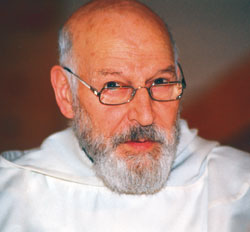 In fact, this return would rekindle the bishop’s spiteful anger, which compelled us to lodge new appeals to Rome. Like the previous ones, they were useless except to prove that the Holy See did not want, because it was unable, to judge Father de Nantes. We cannot imagine the repercussion that this dereliction of duty had in the soul of our Father, who was already affected by Parkinson’s disease, although he was still unaware of it.
In fact, this return would rekindle the bishop’s spiteful anger, which compelled us to lodge new appeals to Rome. Like the previous ones, they were useless except to prove that the Holy See did not want, because it was unable, to judge Father de Nantes. We cannot imagine the repercussion that this dereliction of duty had in the soul of our Father, who was already affected by Parkinson’s disease, although he was still unaware of it.
His visit to Canada in 1997 was apparently a true consolation for him. All the more was it so for us, who were happy to see him again when we did not think that we would see him so soon. That year, he instituted here a little ritual to which he remained very attached until his last visit. In the evening, after blessing the brothers and sisters at the end of Compline, he wanted each family as a whole to advance one after another to the communion rail to receive in turn his benediction. He was happy to see their number increase from year to year and, for some of them, there were three generations who came together. The parable of the vine was not disproved: the branch that remains on the vine bears fruit… but it must be pruned!
Since the inauguration of the chapel of the new Maison Sainte-Thérèse – he appreciated its warm and peaceful atmosphere – he especially liked to pray at the feet of the statue of Our Lady of Fatima. It was there in 1993 that he had the inspiration to begin the Angelic Salutation by « I love Thee, O Mary ».
In 1997, however, it was “worse”! He wrote to Brother Bruno: « The Blessed Virgin let me be carried away by a sudden torrent of devotion to Her Immaculate Heart and I resolved to promise Her to maintain myself in this very exaggeration of words and practices that I had the misfortune of criticising in others so many times in the past, and even in saints. To do this I determined to consecrate my wretched heart, taking advantage of the salutary effect of the dreadful purgatory of these past twelve months, not for one year or for ten, but for all this last part of my life, thus aiming to atone for all the effects and lapses of a too long procrastination. »
He experienced the same consolation a few days later, at the feet of the Virgin in Her sanctuary at Cap-de-la-Madeleine.
 This enthusiasm would lead to his decision to « give way to the Immaculate » and to our consecration to the Immaculate Conception, on the following December 8. Without our realising it, it was indeed hisvia crucis that was looming, which he would suffer alone, in order to set the divine seal on his whole work and draw down on us many blessings.
This enthusiasm would lead to his decision to « give way to the Immaculate » and to our consecration to the Immaculate Conception, on the following December 8. Without our realising it, it was indeed hisvia crucis that was looming, which he would suffer alone, in order to set the divine seal on his whole work and draw down on us many blessings.
In fact, his visits in 1998 and 1999 were far sadder. His disease had progressed, but above all our Father’s soul was overwhelmed with anguish. We saw him torn between his duty to continue the combat for the defence of the Faith, and his concern for being in obedience, for not breaking away.
His solitude was terrible: we were unable to help him in the least because we were his disciples and we were only able to repeat to him what he had taught us. As for the authorities of the Church… they refused obstinately to judge. The Blessed Virgin also remained silent, and this is what must have been the most distressing thing. It was the hour of sacrifice.
The following years, his visits were more peaceful, although the disease progressed, hindering more and more his capacities and thus his activities. Yet how many lessons of humility and courage he gave to us then, in his fear of yielding to laziness when he felt powerless to work, and his energetic refusals in the evening to retire earlier to rest, despite his obvious exhaustion, in order not to deprive us of Chapter or of his presence at Compline.
That is how it was until 2002. That year, two days after his return to France, we had to announce to him the sudden death, during his sleep, of our Brother Hugues du Christ-Roi, his nephew, « this pure, pious, loving and charming child ». The refusal of the Bishop of Trois-Rivières to grant him an ecclesiastical funeral in the parish church cut him to the heart. In his love for the maternal Church, he had absolutely refused to envisage such an attitude when we suggested the possibility: « They cannot do that! » Well, they did it!
Straightaway, he gave us the order to remain silent, to write immediately our submission to the bishop. We had to accept this injustice also in order to bear witness to our attachment to the Church. The highroad had now become a via crucis!
For our brother’s commemorative image, Father chose one of his photos, taken under the peristyle of the basilica of Fatima, because in it he appeared serious.
In the following days, our Father’s disease worsened, certainly due to the effects of this shock. In 2003, he was unable to make the trip. He came the following year, however, for the last time. It was the ultimate effort of his paternal heart, at the extreme limit of his resources. He was visibly happy to be here, despite his fatigue, and to see once again his dear Canadians, his « beloved » as he used to speak of them in France.
Since then the small flock has remained faithful, but not without a grace that can only be attributed to the Immaculate Conception, Mother of us all, and to the sacrifice of our beloved Father. Already in 1996, after his departure under duress, he had written to us:
« People believe that we are a sect and that I am a guru, a foul guru for that matter. If the guru leaves, then all his blindly devoted, hypnotised followers will go away liberated, to find other masters, undoubtedly better ones. It is of no avail to pool all our goodwill, to protect ourselves with cogent resolutions against these worldly suppositions: a charismatic or sectarian group cannot survive if it is decapitated, if it loses its leader. On the other hand, Catholic religious Orders, willed by God, blessed by Him, outlast their founder and travel down the ages. In the trial that we are suffering, we can give proof, through this miracle, that God’s blessing is upon us. »
May he help us paternally from Heaven above.
Brother Pierre of the Transfiguration.
The Catholic Renaissance n° 176, March 2010
The term « Quiet Revolution » refers to the ruinous social, political and religious transition that took place in French Canada from the early 1960s. Here is what our Father wrote in 1984 concerning it: « What is the so-called “Quiet Revolution”? […] This takeover in Quebec by the progressivist, socialist and secularising Christians in 1960 provoked an unprecedented secularisation of society, a debasement of civilisation, mental and moral anarchy. Suddenly the Church was confronted with a colossal challenge. Would she accept such a public apostasy, such an emancipation of society beyond her authority and beyond that of her divine Master? In accordance with her conciliar spirit, she accepted it all. She materially, then morally and finally spiritually disappeared, abandoned, resigned. Quebec is conspicuously a pagan land in which the progressivist clergy is present only through its political commitments, which are excessive and moreover grandiloquent ».
When Fr. de Nantes went into exile in Switzerland in September 1996 to obey to Bishop Daucourt’s order, Father had asked the bishop to paternally care for the Communities that he had founded. In December 1996, however, it became apparent that the bishop was seeking to use all the means at his disposal destroy them. CCR n° 288 (pp.21-24), September 1996, CCR n° 292 (pp.1-6), January 1997)